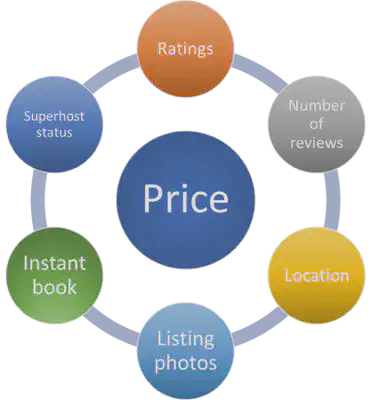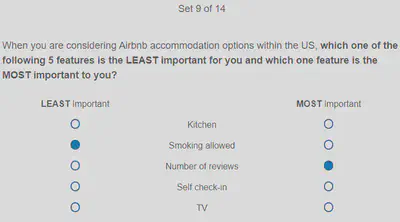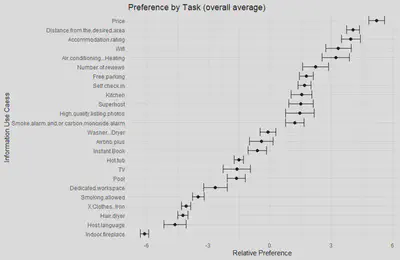Evaluating Airbnb's Preferred Features

Summary: Airbnb has millions of users searching for accommodations around the world. Given the vast number of available listings, Airbnb recommends listings to users using an algorithm model that considers a number of various listing features and characteristics. Although Airbnb is transparent in which factors they consider influential to their recommendation algorithm, a key question is whether these factors align with users’ perspectives. Through a MaxDiff survey and follow-up user interviews, findings indicated that price, location, and rating align well with users’ perspectives, yet features such as self check-in, superhost status, and instant book were less important than expected.
Role: Individual Researcher
Objectives
The goal was to understand users’ preferences for Airbnb listing features and whether Airbnb’s recommendation algorithm aligns with users’ feature preferences.
Aligning Airbnb’s recommendation algorithm with users’ perspectives and preferences ensures that the most appropriate accommodations are presented to Airbnb users. By providing accommodations aligned with users’ needs, we can provide more personalized recommendations to reduce the time required for conversion.
Airbnb’s Recommendation Algorithm
Airbnb is transparent about which features they use for their recommendation algorithm. Therefore, I used their specified features as comparisons. Three key characteristics are heavily prominent in their algorithm: Quality, popularity, and price.
Quality. The algorithm assesses many characteristics to evaluate quality, including the listing photos, reviews of the listing, and listing characteristics. Higher quality listings tend to rank higher in search.
Popularity. The algorithm evaluates the popularity of a listing using a wide range of information, including how guests engage with the listing and how often the listing gets booked. Examples of guest engagement with a listing include how often guests save a listing to their wish list, how often guests book, and how often guests message the Host. More popular listings tend to rank higher in search.
Price. To determine how attractive the price of a listing is, the algorithm considers a variety of price data, including how the price compares to similar listings in the area for the given dates. Listings that are priced below other comparable listings—other listings in the area with similar guest capacity and amenities—tend to rank higher in search.
Other factors that Airbnb mentions as influencing their search recommendations include:
- Location
- High quality listing photos
- Accurate list of amenities
- Superhost status
- Instant booking
- Guest influence
To focus on features selectable by users, 7 features were selected as core influencers of Airbnb’s recommendation algorithm:

Goals
- Identify which Airbnb listing features/characteristics that are most or least important when selecting accommodation.
- Identify whether users’ perceived feature importance matches the current recommendation algorithm.
Target Population and Constraints
- Airbnb users
- College graduate students and young professionals residing in the US
- Accommodation in the US
Method
Two methods were used to collect participant data.
- A MaxDiff survey was administered to understand users’ ranked preferences of listing features.
- Follow-up user interviews were conducted to explore users’ responses in detail.
MaxDiff
A MaxDiff survey is similar to a conjoint analysis whereby individuals are forced to make a choice between multiple items.
Advantages of the MaxDiff survey:
- Good discrimination among items as participants are forced to select their most preferred and least preferred feature from a small subset of items, rather than rating everything as a 4 or 5 out of 5 for importance.
- Minimizes scale use bias in that “most” and “least” is consistent across diverse participant demographics in contrast to Likert-Like scales developing different response bias.
- Easy to administer.
- Works well with a small number of participants.
Identifying Comparable Features
Collate all available features to filter on Airbnb.
Pre-test user interviews with 3 individuals to discuss comparable features
- Discussed combining features that were relevant (e.g., smoke alarm and carbon monoxide alarm)
- Identified uncertainty in features (e.g., what is considered “breakfast”)
Define set list of target features
- Kept certain items together (e.g., air conditioning and heating; washer and dryer)
- Excluded accessibility features. Through discussion with others, we did not want to overshadow accessibility needs when recruiting from the general population.
Cognitive walkthrough when pilot testing the survey to identify areas of confusion and add explanations at the start of the survey.
The final survey included 24 features with the following question and items (bold indicates feature involved in Airbnb recommendation algorithm):
“When you are considering Airbnb accommodation options within the US, which one of the following 5 features is the LEAST important for you and which one feature is the MOST important to you?”
| Listed Features for Comparison | ||
|---|---|---|
| Number of reviews | Accommodation rating | Price |
| Instant book | Distance from the desired area | High quality listing photos |
| Superhost | Dedicated workspace | Hair dryer |
| Kitchen | TV | Washer / Dryer |
| Wifi | Free parking | Hot tub |
| Indoor fireplace | Pool | Smoking allowed |
| Host language | Air conditioning / Heating | Self check-in |
| Airbnb plus | Smoke alarm and/or carbon monoxide alarm | (Clothes) Iron |
With a MaxDiff survey, participants were provided with 14 sets of questions with each set presenting 5 random features.

Findings
Survey
Using data from 28 respondents:
- Price has greatest relative preference in listing features.
- Next is distance and accommodation rating, followed by wifi and air conditioning/heating.
- Only slightly positive preference for Superhost status and high quality listing photos.
- Relatively indifferent preferences for Airbnb Plus and Instant Book.
- Fireplace consistently rated as the least preferred feature.
For those interested, the raw relative preferences are shown below:

Interviews
Follow-up user interviews with 4 participants found several insights:
Misalignment of what key Airbnb features are
Participants were confused on what Superhost and Airbnb plus were.
Superhost: “A Superhost is a nice feature if I am willing to give up autonomy”
Airbnb Plus: “It’d be less overall fees potentially, or it’s like all fees grouped together in one go … I know that’s probably not the right definition.”
Accommodation ratings and review number have a complicated relationship
Accommodation rating generally had greater preference than the total number of reviews, yet participants would skim reviews to make their final determination.
“I will take more risks with fewer reviews because everyone has to start somewhere … I would prefer a 4.6/5 with 100 reviews over a 4.8/5 with 5 reviews.”
Host interaction (well, lack of) matters!
Participants mentioned a preference against interacting with a host at the accommodation, sometimes assuming host interaction is a part of Superhost status.
“I don’t really prioritize the social interaction of the host. I don’t always know who the host is. Sometimes they’re a little weird.”
Physical self check-ins can be a scavenger hunt!
One participant mentioned a bad experience of trying to search for a physical key external to the accommodation, but had good experiences with digital self check-ins.
“They sent me photos of where to find the key. I have to walk out from the apartment, turn right, find a tree, and the key lock is under the tree. What would happen if someone decided to cut that tree? or if there was a storm or something?”
Practical Recommendations
- Enhance understanding of Airbnb specific terms such as Superhost and Airbnb Plus.
- Add a “general vibe” of reviews.
- Restructure what listing characteristics users can filter by:
- Enhance visibility of potential in-person host interactions.
- Differentiate physical and digital self check-ins.
Final Thoughts
- Qualtrics is a good start at conceptualizing and learning the MaxDiff survey; however, a dedicated survey tool (e.g., Sawtooth Software) would be better if administering MaxDiff consistently.
- Focus groups may provide more detailed information than independent follow-up interviews - allowing for distinct motivations behind high- and low-preferenced features rather than overall sentiment.